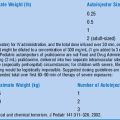Chapter 50 Abdominal Trauma
4 Which injuries may result from a direct blow to the midabdomen, such as from a bicycle handle bar or abuse?
5 When is it appropriate to assess for abdominal injury in the pediatric patient with multiple trauma?
American College of Surgeons’ Advanced Trauma Life Support program. Available at: www.facs.org/trauma/atls/index.html
7 What is the appropriate management of a child with a normal abdominal examination who appears to be at low risk for injury?
15 What are the indications for laparotomy for pediatric abdominal trauma?
Table 50-1 Indications for an Emergent Laparotomy for the Pediatric Trauma Patient
17 How often do pediatric patients require operative versus nonoperative management of blunt abdominal injuries?
1 Nonoperative management is appropriate for > 90% of pediatric patients with an abdominal injury.
2 Clinical instability is the most important indication for an emergent laparotomy in the child with an abdominal injury.
3 Hemoperitoneum in the stable pediatric trauma patient is not an indication for laparotomy.
4 Physical examination findings in the child with a bowel perforation may be clinically silent for 6–24 hours.
5 Laboratory tests (hematocrit, urinalysis, aspartate aminotransferase, alanine aminotransferase) are excellent adjuncts to the physical examination to screen for an abdominal injury in the stable pediatric patient.










